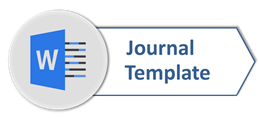A Multimodal Discourse Analysis of Promotional Posters in IDB Bali
Abstract
This study aims to analyze the communication strategy through poster by applying Fairclough 3-Dimentional Model theory. This study analyzes posters from institution which concerns on education, specially design and business in Bali area. This study arises since the change of society due to Covid-19 effect that makes branding becomes very important nowadays and branding through social media is the most popular trend to attract the interest of the visitor page to get the information. The poster analyzed in this study was a poster published in social media which was Instagram, especial Instagram of Institut Desain dan Bisnis Bali. The poster was specified only the poster which has promotional purpose. This study is a descriptive study which applies 3 layers such as text analysis, processing analysis, and social analysis. The result showed that there are 2 comparison discourse patterns, 8 statement discourse patterns, 0 opposite discourse pattern and 2 command discourse patterns which can be concluded that statement discourse pattern is mostly used in IDB Bali Promotional content in which the statement is mostly explaining about the importance of cyber security and the opportunity to learn cyber security in IDB Bali while having the chance to be part of cyber security company.
Full Text:
PDFReferences
Aberšek, B., Flogie, A., & Kordigel Aberšek, M. (2023). Transformation of education: From dehumanization to re-humanization of society. Science and Technology Education: New Developments and Innovations, 18–27.
Al, E., & Andirfa, M. (2018). Pengaruh biaya promosi terhadap volume penjualan pada PT. Ima Montaz Sejahtera Lhokseumawe. 4, 11–18.
Akihary, W., Maruanaya, R. F., Lestuny, C., & Maruanaya, S. P. (2023). The YouTube-assisted discovery learning model: Improving students’ cognitive learning outcomes and critical thinking. Journal of Education and Learning, 17(4), 548–554.
Bushmeleva, N. A., Isupova, N. I., Mamaeva, E. A., & Kharunzheva, E. V. (2020). Peculiarities of engineering thinking formation using 3D technology. European Journal of Contemporary Education, 9(3), 529–545.
Butyrina, M., Hyrina, T., Penchuk, I., Bondarenko, I., Skurtul, G., & Tiapkina, N. (2022). The development of innovative media education styles in the era of information and communication technologies. Journal of Curriculum and Teaching, 11(1), 195–207.
Fairclough, N. (1995). Critical discourse analysis: The critical study of language. Longman Group Limited.
Fernandez-Batanero, J. M., & Colmenero-Ruiz, M. J. (2016). ICT and inclusive education: Attitudes of the teachers in secondary education. Journal of Technology and Science Education, 6(1), 19–25.
Garuda. (2023, December 18). Data pengguna AI di Indonesia 2023. Garuda Website. Retrieved from https://www.garuda.website/blog/data-pengguna-ai-indonesia/
Inez. (2023, November 21). Ciptakan brand fashion sustainability, 4 mahasiswa IDB Bali raih juara 1 KMI Expo bersaing dengan 400 tim perguruan tinggi se-Indonesia. Retrieved from https://www.idbbali.ac.id/berita/4-mahasiswa-idb-bali-juara-1-kmi-expo-bersaing-dengan-400-perguruan-tinggi/
Irwandani, I., Suyatna, A., Haenilah, E. Y., & Maulina, D. (2024). Readiness of Indonesian pre-service science teachers for society 5.0. Journal of Education and Learning, 18(2), 391–402.
Johnson, D. M., Doss, W., & Estepp, C. M. (2024). Using ChatGPT with novice Arduino programmers: Effects on performance, interest, self-efficacy, and programming ability. Journal of Research in Technical Careers, 8(1), 1.
Korucu, A. T., & Totan, H. N. (2019). Researching into a course of information technologies and software in the context of digital citizenship through student opinions. Participatory Educational Research, 6(1), 84–97.
Mufrida, I.E. (2024, March 1). Pertumbuhan perekonomian Indonesia pasca pandemi. Retrieved from https://data.goodstats.id/statistic/pertumbuhan-perekonomian-indonesia-pasca-pandemi-DcTyS
Mutisya, S. M. (2020). Integration of information communication technology in teaching: The underpinning factors among Kenya’s primary school teachers. 7(2), 174–189.
Novoa, M. (2018). Innovating industrial design curriculum in a knowledge-based, participatory and digital era. Design and Technology Education, 23(3), 154–204.
Nuryadi, M. H., & Widiatmaka, P. (2023). Strengthening civic literacy among students through digital literacy in society 5.0. Journal of Education and Learning, 17(2), 215–220.
Odell, B., Galovan, A. M., & Cutumisu, M. (2020). The relation between ICT and science in PISA 2015 for Bulgarian and Finnish students. Eurasia Journal of Mathematics, Science and Technology Education, 16(6), 1–15.
Özcan, K. (2016). Reviewing media and technology usage and attitudes of students of arts and crafts teaching in terms of several variables. International Journal of Curriculum and Instruction, 14(3).
Perlado-Lamo-de-Espinosa, M., Papí-Gálvez, N., & Bergaz-Portolés, M. (2019). From media planner to media expert: The digital effect in advertising. Comunicar, 27(59), 103–112.
Rahmawan, A. Z., & Effendi, Z. (2021). Implementasi society 5.0 dalam kebijakan dan strategi pendidikan pada pandemi COVID-19. Jurnal Inovasi Strategi dan Model Pembelajaran, 2(1), 34–43.
Sá, M. J., & Serpa, S. (2022). Higher education as a promoter of soft skills in a sustainable society 5.0. Journal of Curriculum and Teaching, 11(4), 1–12.
Santoso, W. (2018). Examining a news discourse of a female politician in Indonesia: Fairclough’s model of critical discourse analysis and its implication in English language teaching. Journal of English Language and Culture, 9(1).
Septaria, P., & Sukana, M. (2021). Strategi pengemasan wisata trekking di Hutan Pinus Wonoasih, Kabupaten Banyuwangi. 9(2), 371–378.
Soboleva, E. V., Suvorova, T. N., Zenkina, S. V., & Bocharov, M. I. (2021). Developing computational thinking of specialists of the future through designing computer games for educational purposes. European Journal of Contemporary Education, 10(2), 462–475.
Toan, H. T., Hai, T. T., & Kien, D. T. (2024). Requirements for information technology application competence for Vietnam agro-forestry students in the time of the 4th technology revolution. Asian Journal of Education and Training, 10(1), 33–39.
Zenrif, M. F., & Mustofa, M. L. (2022). Indonesian economic recovery after COVID-19 pandemic: Qur’anic paradigm in community economic development. Nusantara Science and Technology Proceedings, 1–10.
DOI: https://doi.org/10.33365/ts.v23i1.4853
Refbacks
- There are currently no refbacks.
Copyright (c) 2025 GDA Wicaksana, Yeni Suprihatin, Dyah Aminatun, Eka Yuniasih

This work is licensed under a Creative Commons Attribution-ShareAlike 4.0 International License.
Teknosastik: Jurnal Bahasa dan Sastra
Publisher: Universitas Teknokrat Indonesia
Address: Zainal Abidin Pagaralam Street 9-11, Bandar Lampung, Indonesia
Website: https://ejurnal.teknokrat.ac.id/index.php/teknosastik/index

Creative Commons Attribution-ShareAlike 4.0 International License






